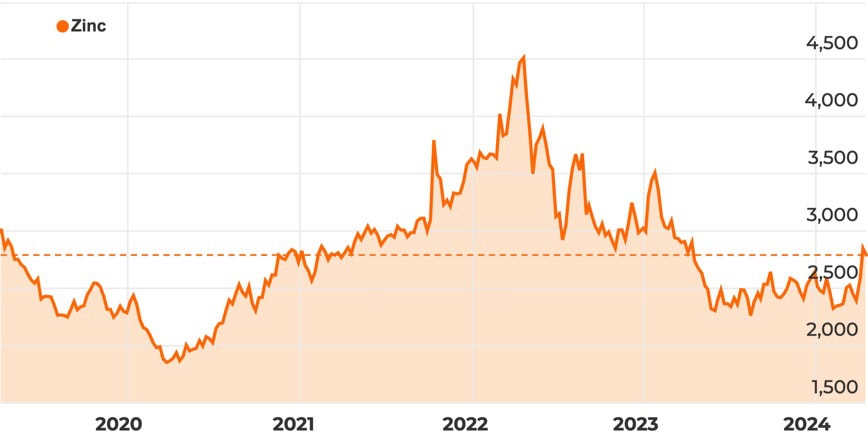Zinc defies forecasts, prices surge as supply tightens and demand rebounds

The zinc price has bucked forecasts predicting a continued slide in its demand and value, jumping by as much as 13% in recent weeks and just over 6% since the start of the year.
According to LiveMint, Zinc is rallying in line with the prices of a number of industrial metals like copper, aluminum and steel due to supply disruptions and increased global demand.
It also pointed to a rebound in demand for industrial metals linked to a resurgence of manufacturing activity in the world’s two largest economies, the USA and China.
Zinc has also benefited as the metals markets considered a potential delay to US monetary easing to focus on looming supply risks.
Counter to forecasts
The recent foray into zinc is in stark contrast to recent forecasts that the demand outlook for the metal would remain subdued due to slowing global growth and ongoing weakness in China’s property market.
According to the office of Australia’s chief economist, zinc consumption is heavily affected by the global industrial production cycle, reflecting its primary role in galvanising steel and its heavy use in the manufacturing, construction and automotive sectors.
In its most recent “Resources and Energy Quarterly,” the Federal Department of Industry Science and Resources reported that world refined zinc consumption rose by an estimated 5.9% year-on-year in the December quarter 2023.
Over the same period, consumption rose in China (12%), ex-China Asia (5.3%), and the European Union (3.1%), though this was offset by a large fall in the US (24%).
Supply disruptions
The quarterly report also noted that mine closures and project delays had disrupted supply in 2023.
“Sharp falls in zinc prices over the past two years have seen unprecedented disruptions to global zinc mine supply, as owners chose to place mines on care and maintenance to cut losses.”
“World mine production fell by around 1.4% year-on-year in 2023.”

Zinc prices have rebounded over 13% in recent weeks.
Despite the fall in mine supply, a surge in refining capacity in China resulted in a rapid decline in the spot treatment price for zinc ore imported into that nation.
The price fell to around US$85 a tonne in February 2024 from an average of around US$181/t in 2023.
Critical mineral
The United Nations has labelled zinc a “life-saving commodity,” claiming that 200,000 childhood deaths could be prevented every year with increased access to zinc.
Zinc has at times achieved the status of being the fourth-most used metal worldwide—behind iron, aluminium and copper.
Zinc has also recently been included on the critical minerals lists for a number of nations, with a growing recognition of its importance in what has been termed the “new energy equation”.
Crucial to net-zero aims
In some quarters, zinc is considered the secret base metal that is critical to reaching net-zero carbon emission targets.
The essential metal is used to make more efficient solar panels and smaller and lighter batteries, which is causing demand to increase while simultaneously the supply chain is getting crunched.
Demand for zinc is expected to triple by 2030 as net-zero targets come into effect.
Zinc production is varied, with more than 50 countries producing the mineral around the world.
